LASAR
Morelaser satellite recovery
The LASAR team (LAser SAtellite Recovery) won the prestigious international Conrad Challenge. They presented a solution for restarting non-communicating satellites in Earth's orbit before experts from NASA and in competition with over two thousand teams. They became one of the few European teams in the finals and the very first from the Czech Republic, and they are now preparing their own satellite. The LASAR team consists of five members and is made up of Czech high school students from gymnasiums in Brno-Bystrc, Ústí nad Orlicí, Plzeň, and Blansko.

LASAR METHOD
The number of nanosatellites affected by software errors is increasing by dozens each year. Currently, nearly 150 such satellites are orbiting the Earth. However, young scientists have come up with an innovative solution. A laser beam will hit the satellite's solar panels, causing them to disconnect from the batteries, which will start to discharge. This undesirable behavior will be interpreted by the satellite's systems as a need for a restart, allowing the error to be resolved.

Inteview with simon klinga
From Czech High Schools to Houston:
How to Restart Satellites?
With the idea of restoring communication with satellites, the team made it to the finals of the prestigious global Conrad Challenge, competing against more than two thousand teams from around the world, which took place in Houston, USA — where they won two out of three awards. “The Czech high school students showed me one of the best presentations I have ever seen,” says the founder of the competition, Nancy Conrad, who is the wife of the late Pete Conrad, the third man to walk on the Moon.
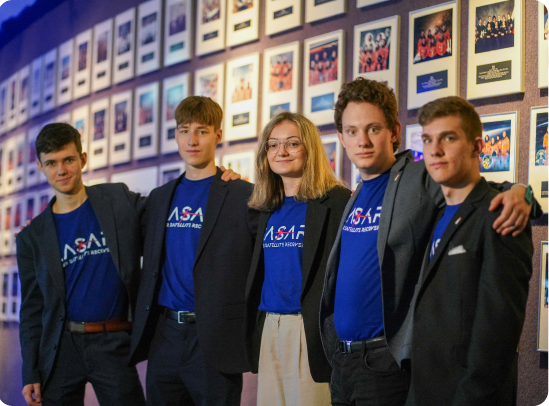
Team leader Simon explains the principle: “With our unique solution, we will be able to trigger a restart on a non-communicating satellite orbiting the Earth.” Physicist Viktor adds: “We will hit the satellite's solar panels with a laser beam, overloading them. This undesirable behavior will cause the satellite's systems to interpret it as a need for a restart, which can resolve the error. In our tests, we will send a signal to the satellite that fixes a minor software bug causing communication issues.”
The launch of new satellites contributes to the growing problem of space debris, which poses a threat to future missions, including those with human crews. The method developed by these Czech high school students could help extend the lifespan of existing satellites, optimizing the utility-to-waste ratio and reducing the risk of the Kessler syndrome—a situation where a high density of objects in orbit leads to cascading collisions.

The team's mentor, Jan Spratek, adds: "This team is every mentor's dream. They are incredibly hardworking, remarkably humble, they listen, and they seek feedback. They are capable of great things!"
Conrad Challenge Finals, but just the
Beginning for Us
The team’s designer, Richard, explains: “To validate our solution, we conducted calculations regarding the necessary laser power, the effects of atmospheric distortions, and the specifications for the required hardware. We developed a demonstrator with a robotic arm and a low-power laser, which was carefully tested and optimized based on expert feedback.”
Mechatronics engineer Boris adds: “Currently, we are working with Spacemanic on our own satellite, which will be launched into orbit by SpaceX's Falcon 9 rocket at the beginning of November this year. It will be a 1U CubeSat, a cube with sides of 10 cm, equipped with sensors for space tests of our method. The goal is to determine how much energy actually reaches the satellite through the atmosphere compared to the amount of energy transmitted from Earth. Most will be absorbed by the atmosphere. Additionally, there will be sensors on board to measure radiation (dosimeter), which will allow us to assess the radiation dose affecting the battery lifecycle. This is crucial for the laser restart method. We will also include a Langmuir probe, which will allow us to measure the ionization caused by the laser near the satellite body. Corner reflectors will enable us to accurately measure deviations while targeting the satellite with an optical telescope. LED lights will also help increase the satellite's brightness.
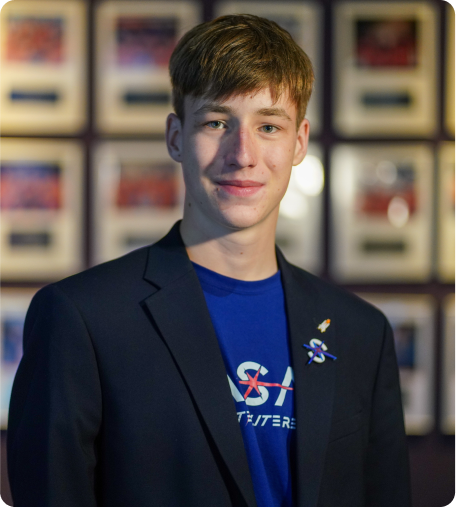
This mission will also feature a special sample of non-alcoholic beer from the VORKLOSTER brand. It will be the first satellite to carry non-alcoholic beer on board. We look forward to the new insights this unique experiment will bring.”
The LASAR team is also collaborating with leading laser centers, such as Hilase, and is working with the Prague Planetarium and the Teplice Observatory. “Our primary target market is operators of small satellites, particularly CubeSats, which are becoming increasingly popular due to their accessibility for smaller organizations, such as universities and non-profits with limited budgets,” concludes Anna, the financial manager.

Lasar Team
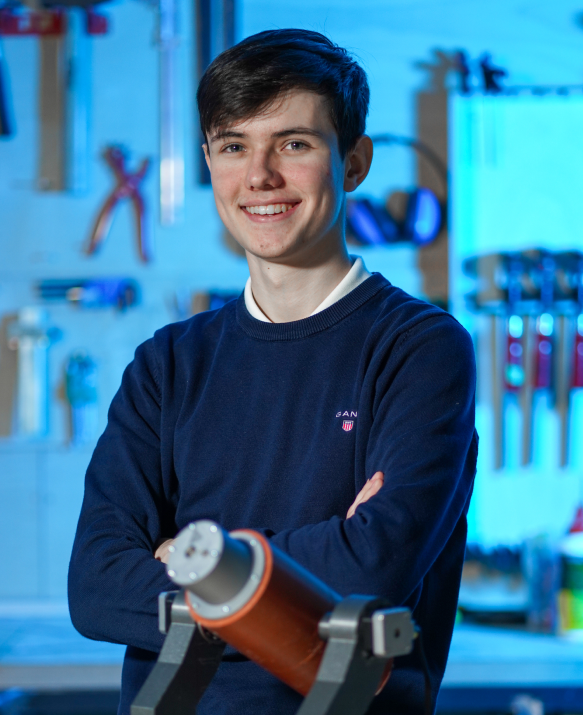
Simon Klinga
leader, age 16
It all started with Star Wars and continued with Elon Musk. Simon is the founder of the LASAR team and an unwavering fan of astronautics and space in general. In addition to leading the team, he is involved in technological development and negotiations with partners.
Since childhood, he has been fascinated by sci-fi movies and books, which sparked his interest in space. This was further inspired by Elon Musk, which led him to engage in space activities. At the age of 12, he began building small rockets and later participated in a simulated mission to Mars as part of the Mars Expedition project, which became one of his greatest life experiences.
Simon's team has achieved several successes, including winning the ESA Hack an Exoplanet competition and placing 2nd in the Český VŠEVĚD 2023 scientific competition. They also presented at a conference in Bologna. Additionally, he is dedicated to promoting science through educational videos and interviews with prominent figures. Currently, his main goal is the LASAR team's project, which focuses on addressing the issue of space debris.

Boris Brovkin
Website Developer, Graphic Designer,
Mechatronic, age 16
Since childhood, he has been fascinated by space and modern technology. He loves diving into the study of the latest discoveries and innovations, which open up new possibilities and push the boundaries of current knowledge. This passion drives him to continuously seek new information and expand his horizons in the fields of science and technology.
He is also interested in architecture and urbanism. He enjoys exploring different architectural styles and urban concepts, thinking about how architecture influences people's lives and contributes to sustainable development. In the team, he handles technical tasks such as engine setup, graphics, website creation, and writing. In the future, he hopes to combine his interests in science, technology, and architecture to contribute to innovative solutions.

Richard Nikel
Engineer, PR, age 17
For over five years, he has been dedicated to popularizing science and space through his YouTube channel "Vědecký Ferin." On this channel, he strives to make complex scientific knowledge accessible to the general public, while introducing the fascinating world of astronomy and astronautics. By conducting interviews with scientists and experts, he brings viewers up-to-date information and unique insights that they might not find elsewhere.
In the LASAR team, he serves as a designer, 3D modeler and social media PR manager. His passion for space also drives him to pursue amateur astrophotography. He has gained experience from various competitions and projects, such as the AstroPi competition, where their code ran on the International Space Station (ISS). Additionally, he is a member of the SpaceCarrots team, contributing to the construction of student rockets. His passion for science continuously motivates him to learn and inspire others.

Viktor Adámek
Brain of All Physics, Engineer, age 19
According to his teammates, Viktor is the main physicist of the LASAR project. He works on calculations related to lasers and their propagation through the atmosphere. He is currently beginning his studies at the Faculty of Nuclear Sciences and Physical Engineering at ČVUT, where he will focus on materials engineering.
Additionally, he leads the rocket team Space Carrots, focused on developing student rockets, with which he has won several awards in the Czech Rocket Challenge competition. Besides that, he creates educational videos for the YouTube channel "Zvědaví". He also participated in a simulated Mars mission (Expedice Mars), and through the Talent Academy project, he completed an internship at the ELI Beamlines laser centers. He is now applying these experiences to the LASAR project. In the fall of 2024, he began studying materials engineering at the Faculty of Nuclear Sciences and Physical Engineering at.

Anna Krebsová
Physicist, HR, Financial Manager, age 18
Anna is an enthusiastic fan of space exploration and aviation. Since childhood, she has been fascinated by technology, which is why technical books dominate her bookshelf over regular literature. Her scientific journey began at the Techmania Science Center in Pilsen, where she developed a love for technical fields, particularly space exploration. Later, her interest expanded to aviation as well.
Thanks to contacts from Techmania, she became a member of the high school rocket team Space Carrots, where she met Simon and Viktor. Together with them, she co-founded the LASAR team, with which they won the international Conrad Challenge. In the LASAR team, Anna is responsible for managing finances, communicating with sponsors and partners, and contributing to the creation of graphic materials and the mathematical-physical calculations of laser systems.
During the Conrad Challenge, she gained many valuable experiences and contacts, which motivated her to pursue a career as a pilot. In addition, she studied for a year at a German high school, allowing her to broaden her knowledge in an international environment. She enjoys traveling and meeting new people and cultures. Her technical interests are balanced by sports, playing the piano, and baking. She also participated in the Mars Expedition competition and the science lecture event "Zvaž vědu!" (Consider Science!).

Karel Horák
Photographer, Business and Marketing
Since childhood, Karel has watched all available documentaries about space and had a library full of encyclopedias on satellites and rockets. His older brother passed on to him a love for technology, especially racing cars and aerospace.
From the age of seven, he and his brother built various models from kits, starting with cars and tracked vehicles, and later, as he gained more experience, even a paper glider with a camera and a range of half a kilometer. At the same time, they followed Elon Musk’s progress as he resumed regular space flights despite repeated failures and setbacks.
In high school, Karel participated in the ESA competition Hack an Exoplanet, where he and a friend received recognition for their project. After the competition, he wanted to continue with scientific activities but encountered age restrictions. He later joined the LASAR team, where he uses his economic skills to plan finances and sales. Additionally, Karel has been practicing photography for six years, focusing on motorsport and ballroom dance. His dream is to become a world-class photographer while remaining an active member of the LASAR team.

Štěpánka Keprtová
PR, Social Media Management
Since childhood, Štěpánka has been interested in science, particularly molecular and developmental biology. In high school, she achieved significant success in the SOČ competition, where her project on "Stem Cell Activity in Mouse Incisors After Damage" earned her 3rd place at the national level. This allowed her to represent the Czech Republic at the International Wildlife Research Week in Switzerland.
She is currently completing an internship at Masaryk University, where she is involved in stem cell research. In May 2024, she successfully passed the AP Biology exam and was awarded the Prize of the Learned Society of the Czech Republic, which confirms her dedication to scientific research. She is also a member of the Program for Gifted Students, providing her with additional opportunities for development. Additionally, she ranked in the TOP100 in the Student of the Year competition, serving as motivation for her continued education in medicine. In the LASAR team, she is responsible for PR and manages social media. These achievements, along with her personal interest in medicine, guide her on the path to pursuing a future in general medicine.

Jan Spratek
LASAR Mentor
Jan Spratek is a professional staff member at the Prague Planetarium and a former space educator at the ESA Education Office. In addition to his work at the planetarium, he is the manager of the LASAR team and co-host of the Czech podcast on space exploration, Czech Space News. His career focuses on popularizing and educating people about astronautics.
What they wrote About us
Czech-founded startup ThinkOrbital has launched a new satellite. Along with it, Czech beer is traveling as well
ThinkOrbital, a space startup co-founded by Vojtěch Holub, has launched an experimental satellite featuring revolutionary space construction technology. The mission's goal was to test welding, cutting, and X-ray inspection using an electron beam. The 45-kilogram satellite was delivered into Earth's orbit by SpaceX's Falcon 9 rocket from California.

Space technologies as an engine of the economy. The government is betting on the space industry
The South Moravian Region is undoubtedly the center of the Czech space industry. Numerous companies operate here, looking up not only in the world of numbers but also literally, as their technologies are aimed at orbit. It is therefore no surprise that the government chose this region, specifically the Brno Observatory, to present the project titled "Czech Path to Space."

Prime Minister Fiala met with the students who succeeded in the international Conrad Challenge competition at NASA's headquarters
On Friday, May 10, Prime Minister Petr Fiala met with high school students at the Straka Academy who received awards in the international Conrad Challenge competition at the headquarters of the U.S. National Aeronautics and Space Administration (NASA) in Houston. The Prime Minister presented them with commemorative certificates as a token of appreciation for their exemplary representation of the Czech Republic in the field of space technologies.
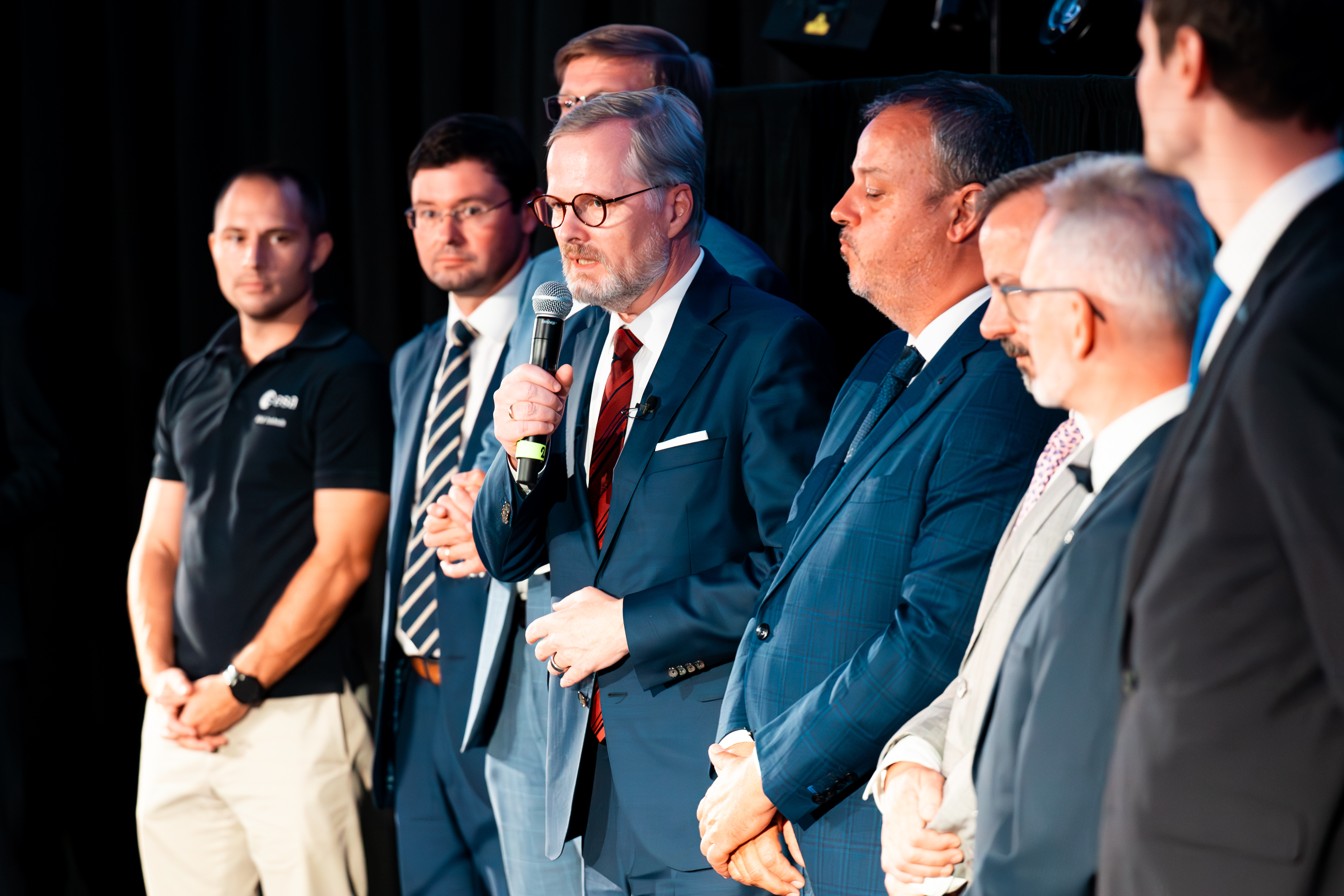
Students from Brno and Blansko succeeded in the international Conrad Challenge competition
The Czech student team LASAR (Laser Satellite Recovery), with a strong representation of students from the South Moravian Region, succeeded in the prestigious global Conrad Challenge at NASA's center in Houston. Their idea for restarting non-functional satellites in orbit stood out among two thousand teams. A total of 26 projects made it to the finals, with the Czech team reaching this stage for the very first time.
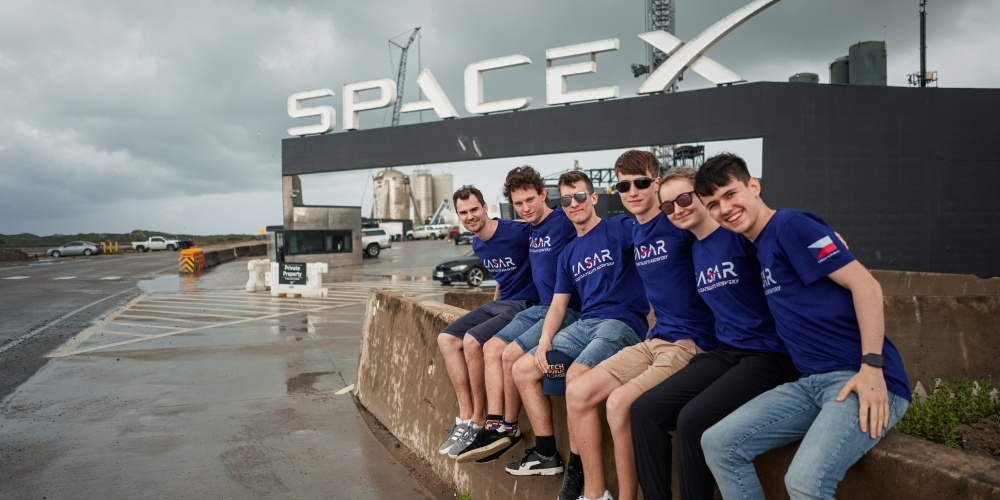
High school students from the Czech Republic came up with a way to remotely repair satellites and succeeded in a NASA competition
A group of five Czech high school students succeeded in the finals of the prestigious international Conrad Challenge at NASA's headquarters in Houston. They won with their idea for remotely repairing non-functional satellites. Thanks to their success, the students were awarded scholarships to universities in the USA.

Czech high school students succeeded in the USA with a project on remotely restarting satellites. They won two out of three categories
A Czech student team succeeded at the prestigious international Conrad Challenge competition at NASA's center. In Houston, USA, they impressed with their project on remotely restarting satellites. This was in competition with more than two thousand student teams.

The Finals of the Prestigious Competition Will Be Held in Houston. A Student from Plzeň Will Also Attend.
A remarkable achievement has been credited to a five-member team of high school students from various corners of the Czech Republic. The team includes three boys from the South Moravian Region, one from the Pardubice Region, and Anna Krebsová, a student from a gymnasium in Plzeň.
